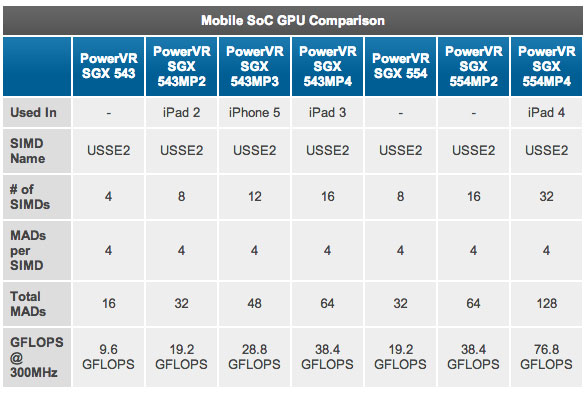iPad 3 or early 2012 New iPad was the first tablet to support a high resolution Display. The trend then shifted everywhere from aamzon Kindle HD to Google’s flagship Nexus 10, making the displays even better.
iPad 4 sports the same 260dpi Retina display as iPad 3, but facelifts the graphics processing by two folds with A6X, as per Apple.
The previous generation chip, the A5X, had two ARM Cortex A9 cores running at 1GHz paired with four PowerVR SGX 543 cores running at 250MHz. The entire SoC integrated 4 x 32-bit LPDDR2 memory controllers, giving the A5X the widest memory interface on a shipping mobile SoC in the market at the time of launch.
Apple SoCs compared: PowerVR SGX 543 vs. 543 MP3, 543 MP4
The A6X retains the 128-bit wide memory interface of the A5X (and it keeps the memory controller interface adjacent to the GPU cores and not the CPU cores as is the case in the A5/A6). It also integrates two of Apple’s new Swift cores running at up to 1.4GHz (a slight increase from the 1.3GHz cores in the iPhone 5’s A6). A quick look at the GLBenchmark results for the new iPad 4 tells us all we need to know. The A6X moves to a newer GPU core: the PowerVR SGX 554.
Why GLBenchmark?
GLBenchmark 2.5 performance testing utility measures different graphic and computation capabilities of your mobile device. The majority of the tests focus on graphic resources, measuring the quality and performance of the underlying OpenGL ES 2.x implementation.
The benchmark contains high-level 3D animations (the new Egypt HD and Egypt Classic from GLBenchmark 2.1) and low-level graphic measurements, optimized for 1080p.
GLBenchmark Fill Test
The pixel fill test is about memory bandwidth a particular GPU has. So a graphics processor with higher memory and faster memory bus takes the crown for this test.
First, lets observer the Onscreen results of Benchmark. The point to note here is that iPad 3 and iPad 4 has nearly 2064×1600 pixels vs humongous 2560×1600 of Nexus 10. So larger screen resolutions will have to render much higher number of pixels and hence slower in benchmarks. Same holds true for iPhone 5 vs Nexus 4 in phones, Nexus 4 has more display pixels.
Onscreen Fill Test gives you better idea of how large loads of Pixels would be handled on device’s screen.
Following are the benchmark results for offscreen rendering. This gives you a better estimate of what GPU is capable of, independent of the screen resolution.
iPad 4’s Power VR SGX 554MP4 simply leads the competition in everything we could test.
If we compare iPad 4 vs. iPad 3, fill rate goes up by around 15%, which isn’t enough to indicate a huge increase in the number of texture units on the 554MP4 vs. the 543MP4. What we may be seeing here instead are benefits from higher clocked GPU cores rather than more texture units. This indicates that the 554MP4 changes the texture to ALU ratio from what it was in the PowerVR SGX 543. The data here points to a GPU clock at least 15% higher than the ~250MHz in the 3rd generation iPad.
Nexus 10 leads the performance in the Android world, however, it doesn’t keep upto iPad’s Power VR 554 MP3, MP4.
GLBenchmark Egygt HD (Offscreen 1920×1080)
Rendering the graphics of Egypt HD simulation shows us the actual potential of the each of the Tablets, Smartphones. This is what matters the most when it comes to Raw gaming power.
image credit: anandtech
Normalize to the same resolution and we see that the new PowerVR graphics setup is 57% faster than even ARM’s Mali-T604 in the Nexus 10. Once again we’re seeing just about 2x the performance of the previous generation iPad.
Clearly, A6X from iPad 4 leads the competition by a big margin. Nexus 10 leads the Android world with its Exynos 5 processor with Mali T604. but its still lacking when compared to iPad 4. But Nexus 10 has no problems running at 2560x resolution even with high-end games like recently released NFS Most Wanted.
We write latest and greatest in Tech Guides, Apple, iPhone, Tablets, Android, Open Source, Latest in Tech, subscribe to us @geeknizer OR on Facebook Fanpage, Google+
loading...
loading...







then we android folk will wait for exynos 5 quad, hopefully with a wider memory bus
loading...
loading...
Apple dualcore vs android Quad Core 1:0…
loading...
loading...